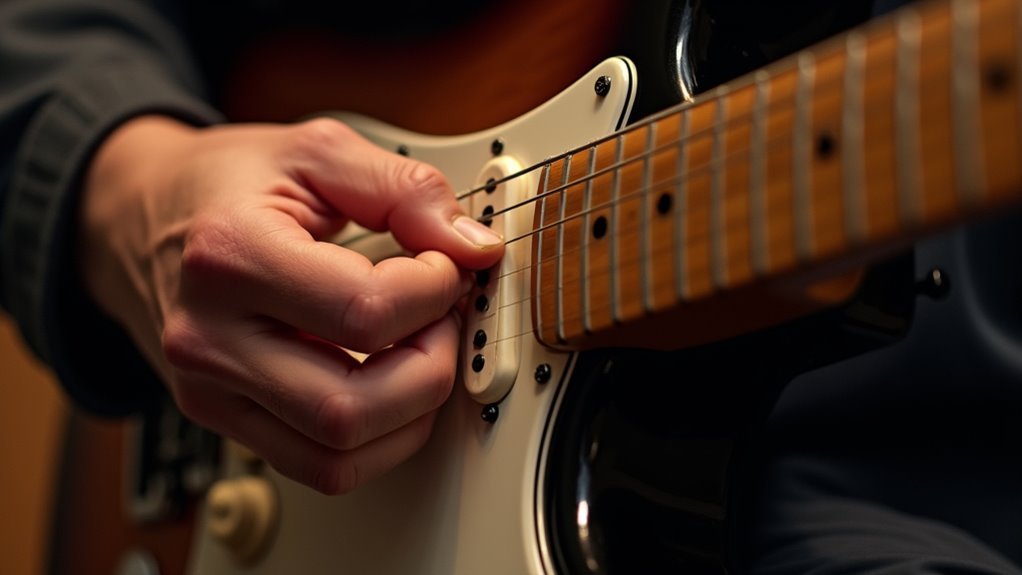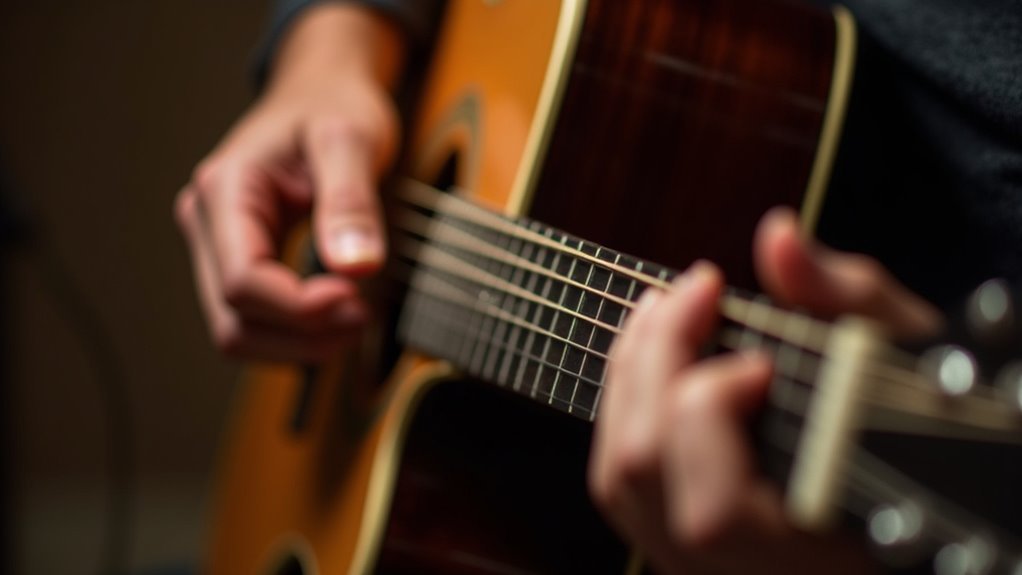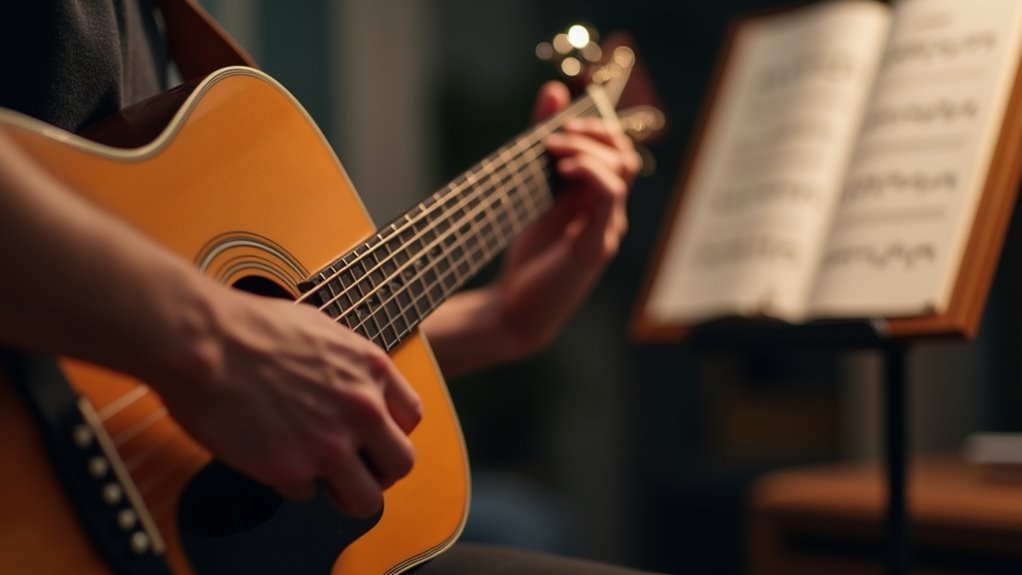We’re about to tackle the most overlooked aspect of guitar mastery: right-hand technique. Let’s face it – your fretting hand might know every scale and chord, but without proper picking control, you’re only halfway there. Think of your right hand as the engine that drives your playing’s precision, speed, and expression. From pick grip fundamentals to advanced rhythmic control, we’ll transform that picking hand from a limiting factor into your secret weapon.
Mastering the Fundamentals of Pick Grip and Position

When it comes to mastering guitar technique, nothing’s more fundamental than getting your pick grip right.
Let’s nail down the essentials of your picking hand position to eliminate tension and maximize control.
We’ll start with your pick grip – hold it firmly but relaxed against the fleshy part of your index finger. This prevents slipping and enables precise control.
Position your right hand at a 30-45 degree angle to the strings, keeping your wrist slightly elevated for peak picking techniques. No palm muting yet – we’re focusing on form.
Keep your picking hand angled between 30-45 degrees with a raised wrist position to develop proper guitar technique fundamentals.
Keep checking your picking hand position throughout practice. Notice any tension? Shake it out.
And don’t forget to experiment with different pick thicknesses – your perfect match is out there.
Master these fundamentals, and you’ll build a rock-solid foundation for advanced techniques.
Building Speed Through Relaxation Techniques
Although many guitarists believe that building speed requires intense muscular effort, the secret actually lies in mastering relaxation.
We’ll focus on exercises that develop fluid picking through mindful, tension-free movements.
Let’s start with slow, deliberate picking exercises while maintaining loose hand positions. We’ll use a metronome to incrementally build speed, but here’s the essential part – we’re watching for any tension creeping in. The moment you feel tightness, dial it back.
Between practice segments, we’ll incorporate hand shakes and stretching to keep flexibility ideal. Don’t forget to breathe – proper breathing techniques keep you calm and focused.
Essential Right-Hand Picking Patterns

Building solid right-hand picking patterns starts with mastering the foundational mechanics that’ll set you up for success. Start with basic down and up strokes, keeping your guitar pick grip relaxed and your movements efficient.
Let’s get your alternate picking game strong. Practice switching between downstrokes and upstrokes while maintaining consistent timing with a metronome. It’s not about speed yet – it’s about control.
Mix in palm muting by resting your picking hand near the bridge; this essential right-hand technique adds texture and dynamics.
Your picking exercises should progress from simple patterns to more complex rhythmic combinations. We’re building a toolkit here – one that’ll serve you whether you’re playing lead or rhythm.
Remember: consistency trumps speed every time. Master these patterns slowly, and the speed will come naturally.
Advanced Muting and Control Methods
Once you’ve mastered basic picking patterns, it’s time to level up your muting game. Palm muting is essential for control dynamics and that chunky sound you’re after. Position your palm near the bridge, experiment with pressure, and find your sweet spot. Regular practice with string changes will build the muscle memory needed for these advanced techniques.
- Master palm positioning through methodical pressure experiments – your tone will thank you
- Practice string changes while muting until it becomes second nature
- Incorporate rhythmic precision into your daily practice routine
- Challenge yourself with complex riffs that demand perfect muting control
Whether you’re diving into metal or funk, proper muting transforms mediocre playing into professional-grade performance. Focus on clean execution and deliberate movements. Your right hand’s control will make or break your sound.
Perfecting Your Rhythm and Timing

Mastering the right hand’s muting techniques sets up your journey into rhythm and timing – the backbone of every guitarist’s arsenal. Let’s accelerate your progress with laser-focused exercises that’ll tighten your playing guitar skills right now.
| Exercise | Purpose | Result |
|---|---|---|
| Metronome Drills | Precision Training | Rock-solid Timing |
| Alternate Picking | Speed Development | Clean Changes |
| Recording Sessions | Self-assessment | Rapid Improvement |
We’re diving straight into Right-Hand Guitar mastery. Start with a metronome at 60 BPM, focusing on alternate picking across strings. Once you’ve nailed clean changes, experiment with syncopated patterns. Record yourself – it’s brutal but necessary. Those recordings will expose timing issues you can’t hear while playing. Remember: rhythmic exercises aren’t just practice – they’re your foundation for everything else you’ll play.
Frequently Asked Questions
How Can I Improve My Right Hand Technique?
We’ll enhance your right hand technique by mastering picking patterns, refining finger placement, practicing strumming styles, using alternate picking, incorporating palm muting, and developing dynamics control through consistent practice sessions.
What Is the Right Hand Technique on a Guitar?
Let’s explore right hand guitar technique, which includes picking patterns, finger positioning, strumming styles, palm muting, hybrid picking, and alternate picking for creating different sounds and rhythmic expressions.
What Is the 80/20 Rule Guitar?
Like a laser beam cutting through fog, we’ll achieve 80% of our guitar progress through 20% of focused practice, targeting essential skills while eliminating time-wasting exercises that don’t greatly improve our playing.
How Can I Improve My Guitar Technique?
Let’s focus on finger placement, hand posture, and pick selection first. Then we’ll gradually build coordination with strumming patterns and speed drills through consistent practice exercises.